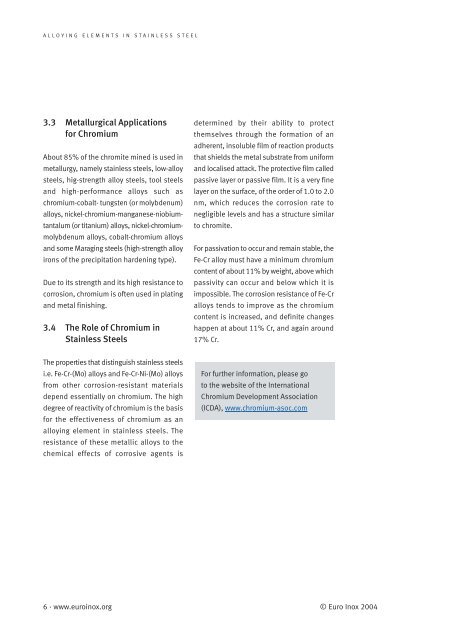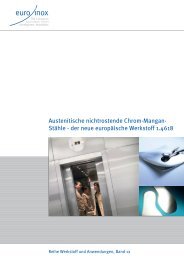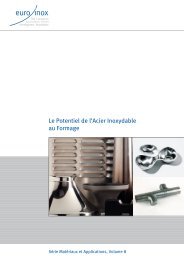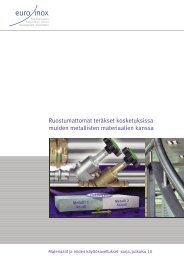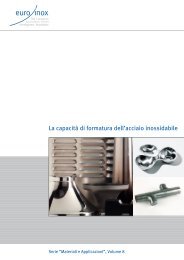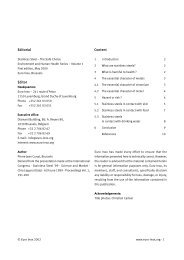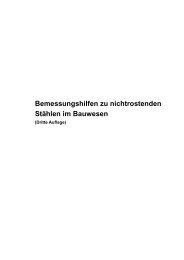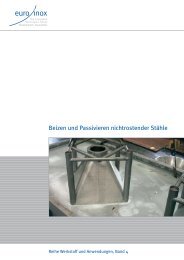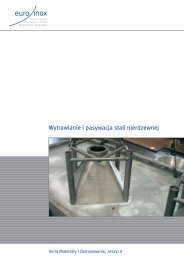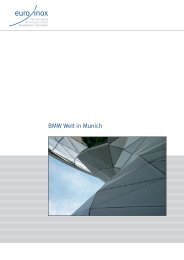Alloying Elements in Stainless Steel and Other Chromium - Euro Inox
Alloying Elements in Stainless Steel and Other Chromium - Euro Inox
Alloying Elements in Stainless Steel and Other Chromium - Euro Inox
You also want an ePaper? Increase the reach of your titles
YUMPU automatically turns print PDFs into web optimized ePapers that Google loves.
ALLOYING ELEMENTS IN STAINLESS STEEL<br />
3.3 Metallurgical Applications<br />
for <strong>Chromium</strong><br />
About 85% of the chromite m<strong>in</strong>ed is used <strong>in</strong><br />
metallurgy, namely sta<strong>in</strong>less steels, low-alloy<br />
steels, hig-strength alloy steels, tool steels<br />
<strong>and</strong> high-performance alloys such as<br />
chromium-cobalt- tungsten (or molybdenum)<br />
alloys, nickel-chromium-manganese-niobiumtantalum<br />
(or titanium) alloys, nickel-chromiummolybdenum<br />
alloys, cobalt-chromium alloys<br />
<strong>and</strong> some Marag<strong>in</strong>g steels (high-strength alloy<br />
irons of the precipitation harden<strong>in</strong>g type).<br />
Due to its strength <strong>and</strong> its high resistance to<br />
corrosion, chromium is often used <strong>in</strong> plat<strong>in</strong>g<br />
<strong>and</strong> metal f<strong>in</strong>ish<strong>in</strong>g.<br />
3.4 The Role of <strong>Chromium</strong> <strong>in</strong><br />
Sta<strong>in</strong>less <strong>Steel</strong>s<br />
The properties that dist<strong>in</strong>guish sta<strong>in</strong>less steels<br />
i.e. Fe-Cr-(Mo) alloys <strong>and</strong> Fe-Cr-Ni-(Mo) alloys<br />
from other corrosion-resistant materials<br />
depend essentially on chromium. The high<br />
degree of reactivity of chromium is the basis<br />
for the effectiveness of chromium as an<br />
alloy<strong>in</strong>g element <strong>in</strong> sta<strong>in</strong>less steels. The<br />
resistance of these metallic alloys to the<br />
chemical effects of corrosive agents is<br />
determ<strong>in</strong>ed by their ability to protect<br />
themselves through the formation of an<br />
adherent, <strong>in</strong>soluble film of reaction products<br />
that shields the metal substrate from uniform<br />
<strong>and</strong> localised attack. The protective film called<br />
passive layer or passive film. It is a very f<strong>in</strong>e<br />
layer on the surface, of the order of 1.0 to 2.0<br />
nm, which reduces the corrosion rate to<br />
negligible levels <strong>and</strong> has a structure similar<br />
to chromite.<br />
For passivation to occur <strong>and</strong> rema<strong>in</strong> stable, the<br />
Fe-Cr alloy must have a m<strong>in</strong>imum chromium<br />
content of about 11% by weight, above which<br />
passivity can occur <strong>and</strong> below which it is<br />
impossible. The corrosion resistance of Fe-Cr<br />
alloys tends to improve as the chromium<br />
content is <strong>in</strong>creased, <strong>and</strong> def<strong>in</strong>ite changes<br />
happen at about 11% Cr, <strong>and</strong> aga<strong>in</strong> around<br />
17% Cr.<br />
For further <strong>in</strong>formation, please go<br />
to the website of the International<br />
<strong>Chromium</strong> Development Association<br />
(ICDA), www.chromium-asoc.com<br />
6 · www.euro<strong>in</strong>ox.org © <strong>Euro</strong> <strong>Inox</strong> 2004


